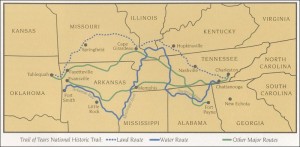By Spenser Hickey
News Editor

“School children of today do not know that we are living on lands that were taken from a helpless race at the bayonet point to satisfy the white man’s greed,” said retired private John G. Burnett in 1890, in reference to the forced removal of five Native American nations during the 1830s.
In the Trail of Tears, as it came to be known, the Cherokee, Creek, Chickasaw, Choctaw and Seminole nations were driven from their lands by the American military, despite a Supreme Court ruling preventing it. Burnett was one of the soldiers pressed into service to lead the Cherokee to Oklahoma.
This October, junior Felicia Rose will lead students in a reenactment of the event at Camp Joy in Clarksville, Ohio, as part of her Theory-to-Practice (TiPiT) grant titled “Leading and Learning Through Diversity.”
“I’m very interested in history and the way it can influence our actions,” she said.
Since her freshman year, Rose has worked with Terree Stevenson, director of Multicultural Student Affairs, to plan the grant and the events. She led students in a similar re-enactment event last fall as part of the project, exploring the experiences of slaves on the Underground Railroad.
“It’s important to learn about American history and learn as much from it as you can,” Rose said. “With this activity students get an interactive, once-in-a-lifetime experience that they weren’t looking for. It’s informative and allows students to interact and learn from new people.”
She and Stevenson plan to get as many students involved as possible, but said she would love to have “around 20” students involved, twice the number of participants as the Underground Railroad event.
Junior Jeunesse Jacobs participated in the Underground Railroad re-enactment and said she’d love to take part in the Trail of Tears event.
She said the Underground Railroad re-enactment was “a great experience” and very eye-opening.
“My biggest take away from this was that not just the African-Americans had something to be scared of, so did those who choose to help them, and that it took a very brave person to take that chance of being killed if they got caught,” Jacobs said in an email.
She said her experience as an African-American in the re-enactment motivated her not to take things for granted and be grateful for all her opportunities.
“People fought long and hard so that we can have the freedom that we have today,” Jacobs said.
Freshman Brittiany Andears said she heard about the program in the OWU Daily and plans to take part in the Trail of Tears re-enactment event.
Andears said that such events are important because they provide “a new view” on the Native American experience.
Students participating will leave OWU around noon on Oct. 26 and return the night of Oct. 27. According to Rose, the program’s details are kept secret to surprise participants.
During the Trail of Tears, forcibly relocated Native Americans had to walk over a thousand miles, from southern states such as Georgia, Tennessee, Florida and Alabama to their government-designated homes in Oklahoma.
It is unclear how many Native Americans died during the marches ordered by President Andrew Jackson. Howard Zinn’s “A People’s History of the United States” gives some information from contemporary news accounts of deaths from specific incidents, but does not list an overall total. Even before they began marching, Zinn writes, nations were moved from their homes into stockade camps where hundreds died of starvation.
In “The New Nation,” part of her 10-volume series “A History of US,” Joy Hakim said one in four Cherokees who started out died because of exhaustion, starvation and the elements.
Russell Thornton’s “Ethnohistory” estimates that as many as 8,000 Cherokee died in the marches; but the lack of population records for Native Americans makes it hard to be certain.
Much of the U.S. government’s treatment of Native American groups during the 1800s meets the United Nations’ criteria for genocide.
The UN defines genocide as “acts such as deliberately inflicting conditions of life aimed at destroying a national, racial, ethnic or religious group and forcibly transferring children of that group to another group, when these acts have the intent of destroying that group, partially or completely.”
According to Alan Taylor’s “American Colonies,” the indigenous population of North and South America dwindled from 50 million in 1490, two years before Columbus’s arrival, to 1.8 million in 1890, the date of the Wounded Knee massacre, the last major conflict between the U.S. government and Native Americans.